Adding Colleague IDs to Courses in Catalog (Acalog) (updated 8/4/2025)
Each course is assigned a Colleague ID. Once you add the new batch of courses to the catalog, you will need to run a report out of Reporting Services to get the Colleague IDs and then enter those into the course in Acalog.
Log into EagleNet
Go to Reporting Services
Go to the Academic Affairs Folder and then to the Registrar Folder
Pull up the report titled “Course ID Report”
It will pull up a blank screen, but you will want to click on the “View Report” button on the far-right side of the screen.
Once the report loads, you can export the file to Excel.
Open the file and unmerge all cells (filters will not work with merged cells).
Delete unnecessary columns if they show up after the unmerge process.
Filter the spreadsheet by “Active”
Filter the spreadsheet by “Name” to not include any blanks.
Sort the spreadsheet by “Name” from Z à A so that all of the current courses show up at the top (they will be in reverse alpha order at this point)
From here, you can use your favorite search method to find the new course that is missing its Colleague ID. For our example, we are going to add a Colleague ID to THE-4920.

Log into Acalog
Go to the new academic catalog.
Go to Courses.
Search for the course for which you need to add the Colleague ID.
Click into the course to edit it.
Scroll all the way to the bottom to where you see Colleague ID.

Enter the Colleague ID and click Next to save when finished.
Repeat this process for all of the new courses or anytime there is a course that is missing its Colleague ID.
Assigning New Course Numbers (updated 9/25/2024)
When departments request a course number for a new course they are creating in the upcoming catalog:
First verify the course (by name/number) is not already in Colleague (CRSE).
If the course is not in Colleague, go to the “AS400” folder at Q:Academic Affairs/Registrar and open the excel document, “AS400 All Course Numbers & Names.” Search by name first to see if a previous course existed in the AS400 system. If there is a similar course name, check with the Registrar to see if you should use/reinstate that existing course number with same or new name, or assign a new number (see additional notes below).
If it is under a new subject that has not been used previously, enter that new subject in Colleague first, under SUBJ. When it says, not found, click on “add” and fill in the subject description and enter “yes” on display in self-service catalog box. To view existing subjects, in SUBJ look up box type “…” to see all of the existing subjects.
To determine a new number, search the AS400 excel file and also search within Colleague CRSE to find an unused number within the parameters given: i.e. “BUS or CYB”; 1000, 3000… level; 1, 2, 3… hours. Send the new number to the department or individual making the request. Keep this information (email) so a newly assigned number does not mistakenly get assigned to another new course (this would happen only in the same catalog period). Add the new course number and name to the master file for that catalog period.
If a similar course will be reinstated per the registrar, send the existing number to the individual making the request and make appropriate notes in your records. When the request comes through a Curriculog proposal, it will come in as a new course (it cannot be a course change since it doesn’t exist in the current catalog).
However, if the course already exists in Colleague, and have it has an end date, reactivate the existing course in Colleague and update the information as provided through the proposal.
The next day, Colleague will assign the course its own unique course ID number. A listing can be found in reporting services. Run a report of courses in Acalog missing ID numbers, search for the new number on the report and fill it in on the course in Acalog. Do not do anything in Colleague with course ID numbers, it is automatic.
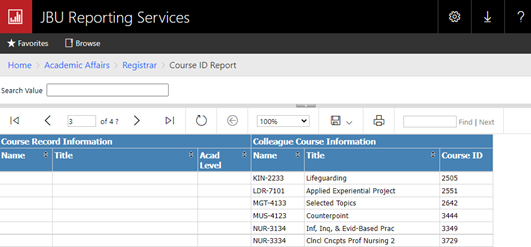
Creating New Draft Catalogs in Catalog (Acalog) (updated 6/5/2025)
Note: This should not be done until after the current draft catalog is published (July 1 of each year). Once the current catalog has been moved from draft form, you can create the future catalog. Once the future catalog has been created, all changes in the current catalog will also need to be made in the future catalog.
Log into Acalog
Select Catalogs from Main Menu

Choose +New Catalog on far right-hand side of screen

Name the new catalog according to the previously used naming convention:
- Undergraduate Catalog 20XX - 20XX or
- Graduate Catalog 20XX - 20XX
Choose the Type that corresponds with the type of catalog you are creating.
Select “Create Copy of Existing Catalog” and copy the most current version of the catalog for this new catalog.
Select “yes” for “Copy user permissions?” and “yes” for “Copy attachments?”. You will want an EXACT copy of the current catalog.

Select “Save”
You do not want to publish this catalog. Doing so will “archive” the current catalog. This future catalog will not be published in draft form (viewable on the gateway) until after the catalog change cycle has been completed in early spring. This catalog will only be viewable in Acalog - it is your working copy. You will publish this catalog in early spring; you will remove “draft” from the name on July 1. And the cycle begins again.
Creating New Proposal Forms (Curriculog) (updated 8/4/2025)
Before the new catalog change cycle opens for faculty and staff, you will need to create new proposal forms in Curriculog for the new catalog. This is typically done in late July and early August. You will have a meeting with the Registrar and OAA (that you will need to schedule) to discuss changes that need to be made based off last year’s work in Curriculog. These will trickle in throughout the year; I saved them to a folder so that I would know what we need to discuss in the meeting. Once you are clear on the changes that need to be made, you can start creating the new proposal forms.
You will need 12 new forms:

Open Curriculog and login
Go to your Administration Dashboard
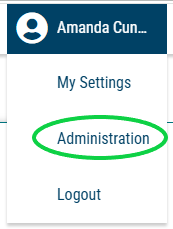
Choose Approval Processes from the top ribbon

When you get to the Approval Processes screen, you should see all of the approval processes that you used for the previous catalog at the top.
For each approval process, you will want to select to the Copy Process button.

When you click Copy Process, you will be taken to a pop up window
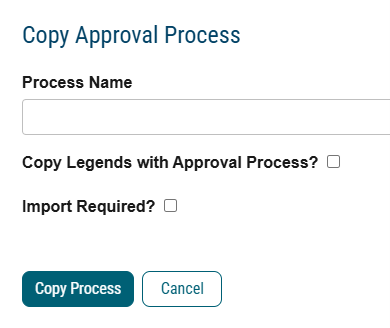
Your Process Name will be the process that you are copying with the new catalog years. For this process, the new name would be 2026-2027 Graduate Course Change.
Always check Copy Legends with Approval Process
If you are copying a change or deletion proposal form, then you will also click Import Required. If you are copying a creation form (course or proposal), no import is required.
(Your proposal will not be live until you make edits in each proposal and launch it. This will be covered in another procedure.)
Once you complete this for all 12 proposal forms, you can then change the name of the previous year’s processes so that they no longer show up at the top of the list.
To do this, you will click on the edit button in the process:

When the approval process opens, you will select “Edit Approval Process” from the top.

When prompted, say “Enter Edit Mode”
Click on the pencil next to the approval process name.

Put a lower case “z” in front of the approval process name.
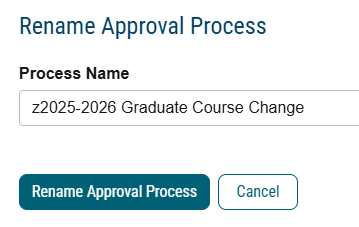
Choose “Rename Approval Process”
Once you have renamed the approval process, you can choose “Relaunch Approval Process”.
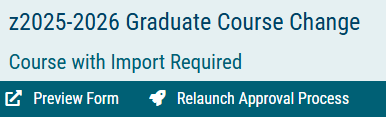
When prompted, choose “Re-Launch Approval Process”. You should always see a “0” on Number of Proposals using this original approval process. This just means that there are no active proposals in Curriculog that are using this approval process and that it is ok to make the change.
Repeat this for all 12 proposal forms
Once you have all of your new proposal forms and you have renamed the old approval forms, you can start making updates to the new forms based off your meeting with the Registrar and OAA. The process for this will be covered in a subsequent procedure.
Making a Text Change (Not Program or Course Related) (updated 12/4/2024)
Sometimes, a request will come in to make a change in the catalog. This might happen because:
- Someone noticed a typo as they were reading the catalog on EagleNet.
- Information has changed and needs to be updated.
See example email from Registrar.
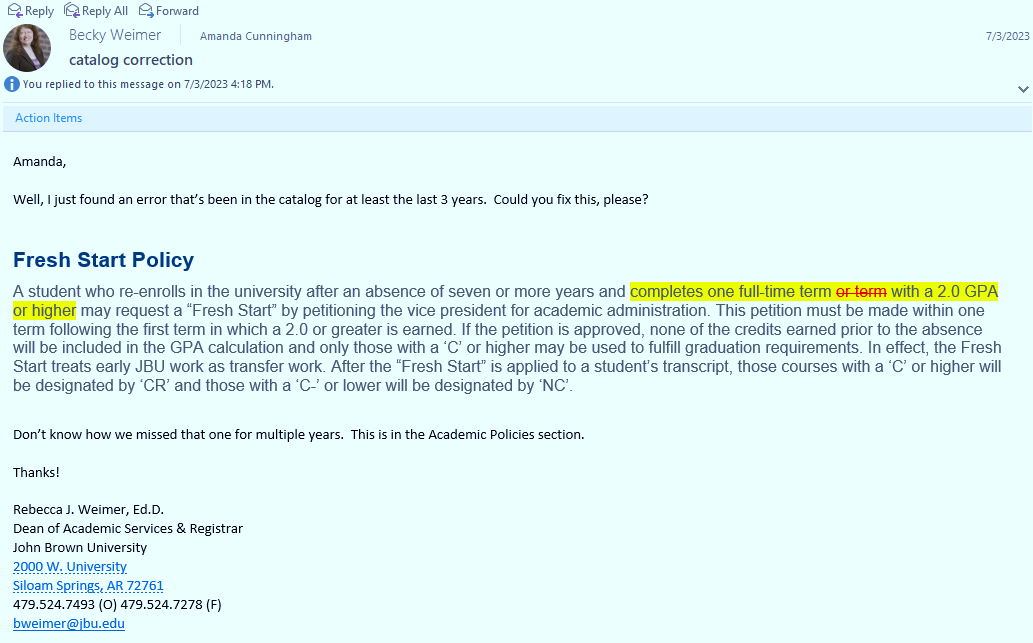
Open Catalog (Acalog)
Choose the catalog to which you need to make the change. If you need to make the change immediately, choose the current catalog. If it is a change that will only apply in the next academic year, choose the future catalog. Once you click on “Go” and a catalog has been chosen, you should see a green bar with “catalog changed successfully” show up.
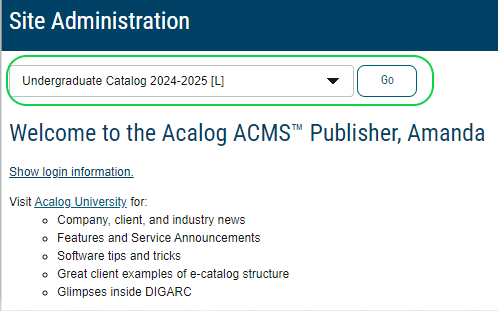
From the main toolbar at the top, choose Catalog Content and then Gateway and Content.

You will then see all of the components that make up the side navigation bar in the actual catalog.
In this instance we are modifying an Academic Policy, so choose the SECOND Academic Policies option in the list of options. (The first one is there as a formatting component.)
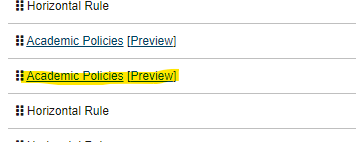
Click on Edit once you have chosen Academic Policies. And then make your viewing window larger by choosing this button.

Scroll through the information in the section until you see the place where edits are needed and make the necessary revisions.

After all edits are made, exit full screen mode by choosing the same button as you did in Step 6.
At the bottom, choose “Next” to save your changes.
You can then choose “Preview” to see your changes as they will appear in the catalog.
It may be tricky to figure out where in the catalog edits need to be made. Sometimes, you’ll just get a small screenshot and you’ll have to go looking for it. The search feature on the current catalog is a good tool to use to see where you need to make the revisions.
Removing a Course from Catalog and Academic Planning (updated 11/27/2024)
Sometimes, a request will come in to remove a course from the catalog outside of the standard catalog change cycle. (Typically, all changes to courses must go through Curriculog. These one-off changes are rare.) However, this type of change might happen because:
- It should have been deleted in the last catalog change cycle and was missed.
- Something has changed since the last catalog change cycle that makes the course obsolete.
See example email.

Removing the course from Catalog:
Open Catalog (formerly Acalog).
Choose the catalog to which you need to make the change. Once a catalog has been chosen, you should see a green bar with “catalog changed successfully” show up.
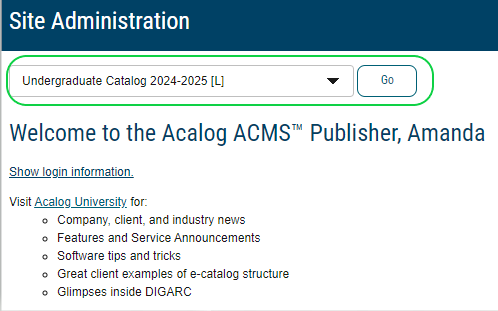
From the main toolbar at the top, choose Catalog Content and then Courses.

Use the filters provided to search for the course you need to change.

Click on the course once you pull it up and choose “edit” from the toolbar.
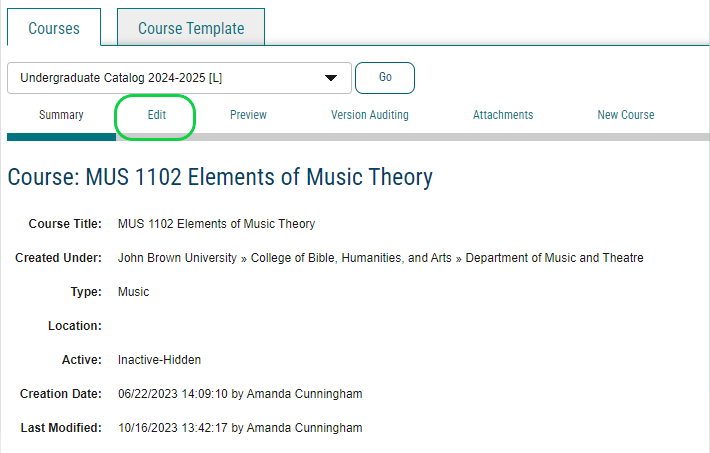
Scroll through the course information. If you see any green links, these are permalinks. They will need to be unlinked before we can move forward. You can do this by deleting the linked text and just retyping it without a link. This preserves the information for the course but removes the permalink.
Scroll all the way to the bottom and uncheck “Course Active?” This makes the course inactive-hidden.

Courses at this point are not deleted in full. They are only made inactive-hidden. We keep them as inactive-hidden for one full catalog cycle before we delete them. For example, this summer, I will delete all of the courses that were made inactive-hidden during last year’s catalog cycle.
Once the box for “Course Active?” is unchecked, click Next. This makes the course inactive-hidden and removes it from the catalog that you are working in.
If you have made the change to the catalog that is currently on EagleNet, you can go to the Academic Catalog to make sure the course is no longer showing.
Removing the course from Academic Planning (Colleague):
Open Colleague.
Go to CRSE (Course).
Select the course you want to modify. In this case, it is “MUS-1102”.
Look at the bottom of the screen and make the course “I Inactive” in the Status smart field. You will use the date when you are making the change, and in this case, I used Becky since she and I worked on the issue with Liesl together.

Save All once the course is inactive.
You can run a force refresh to Colleague Production to make sure that your changes are showing properly in Academic Planning. The link for the force refresh is: https://veri.eaglenet.jbu.edu/app-pool-restart/
You can also check to make sure that there are no current sections being offered under “Offering Info”. If there are current sections, the course should not be made inactive. Will need to wait to make it inactive once those sections are complete.
Removing Inactive-Hidden Courses from New Draft Catalogs (updated 6/9/2025)
With each new draft catalog, you will need to remove courses and programs that were marked as inactive/hidden in the current catalog. This process should happen after you have published the current catalog (no draft in title) and created the future draft catalog (not published, your working copy).
Open Acalog
Choose the Current Catalog
Select Integration (top search bar) and then Export from the drop down menu
Select Programs & Courses Export
To Remove Inactive/Hidden Courses
Choose “Export courses to XLS (.xls) and click on Export
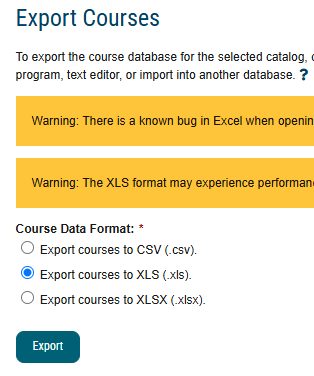
When the export is complete, click on “download file”. Open the file in Excel.
Enable Editing (at the top)
Apply a filter to the entire workbook and filter by the column named “Is Active”. You will want to choose to view all “0” courses as these are the inactive/hidden ones.
Once you are seeing only “0” courses, you can delete all columns except Prefix, Code, Name and Is Active.
At this point, I would copy the data and add it to my master spreadsheet for the catalog so that I know which courses were deleted.
Go back to Acalog and select Catalog Content (top search bar) and then courses from the drop down menu.
Search for the first course on your list.


Click into the course and select Edit.

Scroll through the course information and remove any Permalinks that are noted. Some may be red and others may be green. All have to be removed before the course can be deleted.
Once all permalinks have been removed, you can select “Delete this course?” at the bottom of your screen.
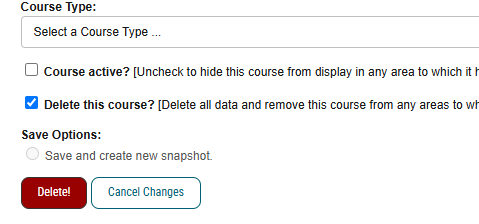
Save by clicking Next.
Only inactive-hidden courses should be deleted. Inactive-hidden courses have been out of the catalog for one full catalog cycle which means that they can be deleted.
Repeat this process until all inactive-hidden courses have been deleted. Make notes as necessary on the master spreadsheet.
Updating Course Templates (Acalog) (updated 8/4/2025)
Occasionally, you will need to modify the course template for all courses in a catalog. This will allow you to import a large amount of data that might be housed elsewhere into Acalog. It is advisable to only make these changes in a draft catalog and not in a current, published catalog.
Log into Acalog and Go to Catalog Content and then to Courses
Choose Course Template

On the right, select + New Course Field
Make appropriate selections based on the field you are adding. If you choose “small text”, it will give one line (max 255 characters). If you need more room in the field, choose “large text”. If you do not want the field to be visible on the gateway, do not select “Show Field Name” or “Field is Visible?”. If you do want this to be seen on the gateway, choose other options accordingly. This is just based off what type of change you are making.
Repeat this process for as many fields as you need to create. In the 2026-2027 catalog, we added hidden/not visible fields for “Faculty Load”, “Funding Source”, and “Funding Notes”. We did not want these to be seen on the gateway and the fields are optional. I will use these three fields as my example in this procedure.
Example + New Course Field
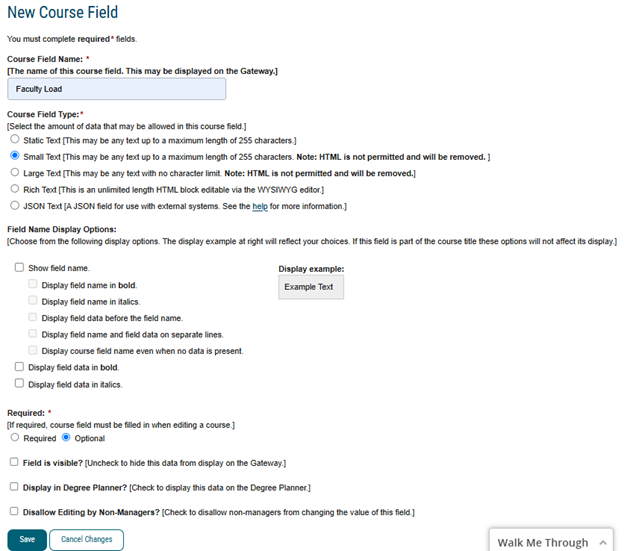
Once you have all of your new course fields added, you can rearrange the order if needed from the course template main screen. Hover over the six dots on the left of the field you want to move and drag it to its new location. Once you have it in the right place, scroll back to the bottom and select “Save Ordering”.
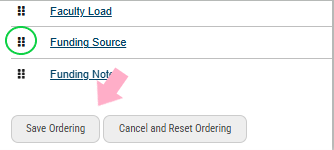
Once your course template is ready, you can begin the process of uploading data that will fill in your new fields. If you do not have any data to upload, this process is finished.
You will need a spreadsheet of information. You can get this by doing a course export and filling in the information, or you may be provided with a dataset. For this project, I was provided with a spreadsheet and I made modifications (to a copy on my computer) to get it ready to import into Acalog.
Your spreadsheet will need to be saved in a .xls format. This is a sample of the modified spreadsheet I used. I deleted all columns except Prefix and Code and the new fields that I had just created.

Go to Integration and Courses Import

Make sure you are still working in the catalog that you want to import new data into.
Choose Courses Import and “Set Restore Point and Import Lock”. This keeps a copy of the catalog before your changes and also locks the catalog while you are working so that no one else can make any changes.

Skip the next section “Choose Data File” and go down to “Upload a Data File”. Upload the file you are using that has your new data. Once your file is uploaded, you can go back to the previous section and click the radial button next to your file. Then you will have a NEXT option.

Once you select NEXT, you will be given some options. For this project, I was modifying existing courses, so I chose “Update: Modifications to Existing Courses Only”. You may choose a different option based on the project at hand. Then you will need to go through and choose your “default” items.
Hierarchy Item Column: Skip
Default Hierarchy Item: Institution: John Brown University
Course Type Column: Skip
Default Course Type: No Type
Location Column: Skip
Default Location: No Location
Course Active Status Column: Skip
Default Course Active Status: Active
Then choose NEXT
The following screen is the Field Mapping section. This is where you will map the fields in Acalog to the fields in your spreadsheet.
For this project, my two Keys were “Prefix” and “Code”. I selected “Key” and mapped them appropriately in the Data Field.

I also wanted to map Faculty Load, Funding Source, and Funding Notes, but those are not Key fields. They map like this:

Next you will Validate Choices. If you have errors, you have to go back and problem solve until they are fixed. If you have no errors, you can proceed.

Scroll to the bottom and select “Run Import Now”.
Once the import has run, you can go back to the main Courses Import screen and either choose to cancel the import process (helps if you spreadsheet has errors that need to be fixed) or Finalize import process. This fully imports the data and removes the restore point that you set up at the start of the import process.

From here, you can spot check your courses to see that the information from your spreadsheet was imported into the courses properly. If so, then you are all set.
Updating Faculty Based Off Academic Personnel Report (updated 6/24/2025)
Before the beginning of each fall semester, OAA will publish the Academic Personnel Report. This is a summary of all new hires in academics. You will need to go into the current catalog and future catalog (if already created) and make updates based off this report. Faculty (and/or administrative staff) that are leaving will need to be removed; new faculty (and/or administrative staff) will need to be added.
Log into Catalog (Acalog)
Choose the correct catalog
Select Hierarchy from the top drop down menu.
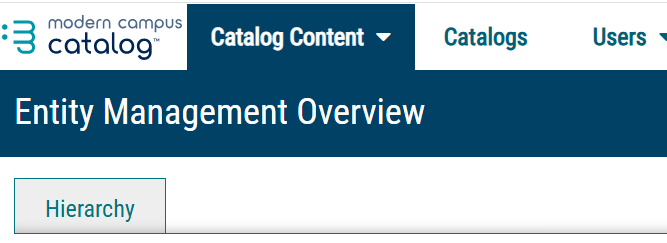
Click on the gray tab for Hierarchy
Faculty names are listed in two places:
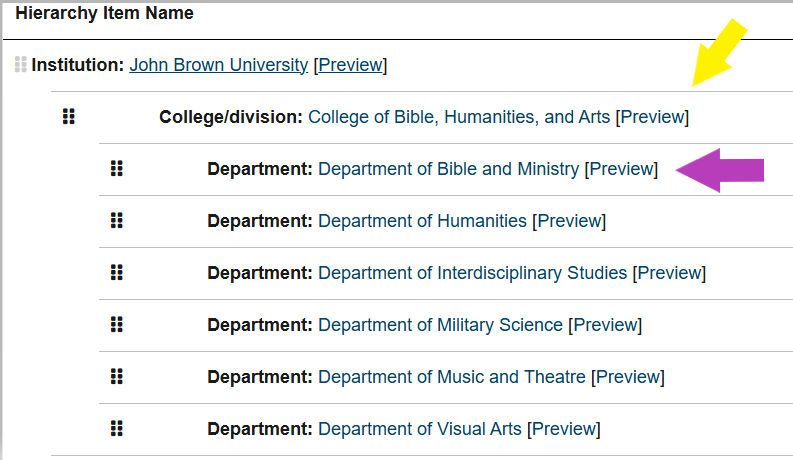
- All faculty in the College are listed in the “College/division” section (yellow arrow)
- Department Chairs are listed in the “Department” section (purple arrow)
Make updates as needed (removing, adding) based off Academic Personnel Report.
Another good place to look to make sure you are removing all instances of a faculty member’s name is to go into the Word document of the current catalog and do a “Find” search. You can also do a search on the catalog on the gateway to catch all instances of a person’s name.

This is not a hard task but something that people will notice if it is not done.
Updating OAA EagleNet Page with Curriculog Proposal Forms (updated 7/16/2025)
During the summer, you will make updates to all of the Curriculog proposal forms in Curriculog. Once these new proposals are ready, you will need to post them to the Academic Affairs page on EagleNet.
You will need to be given access to edit the page in EagleNet from the Help Desk.
Save a PDF of each of the Curriculog proposal forms (this is done in Curriculog).
Log into EagleNet
Search for Academic Affairs in the search bar
Choose “Curriculog” from the list of options
Once on the Curriculog page, click on the three dots on the upper right-hand side of your screen
Select “Edit Page”
Scroll down to the bottom where you see “Catalog Change Proposal Forms”; there should be 12 proposals (six for undergraduate and six for graduate)
Right click on each item and Select “Remove Link”; this will allow you to rename each proposal with the new catalog years
Update all 12 items with the new catalog years
Scroll over to highlight one of the forms that needs to be updated
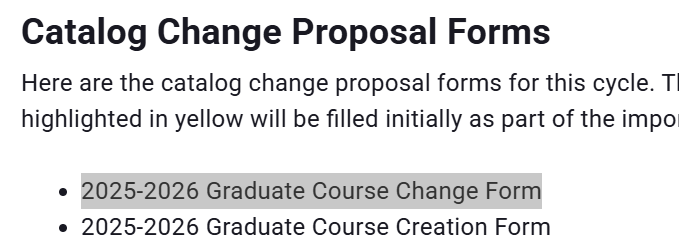
Click on the file upload button in the top ribbon

Choose “Upload a File” when the “Insert A File” window opens
Choose the proposal form that you saved from Curriculog that matches the form you are changing in EagleNet.
Change the “File Label” to match the name of the proposal form if it does not already match.
Choose “Save”
Repeat this process for all 12 proposal forms
When all have been updated, click “Publish Page”
Updating Proposal Forms (Curriculog) (updated 8/4/2025)
Once you have created your new proposal forms in Curriculog, it is time to start making changes to these to prepare them for the new catalog cycle.
Start by adding all of the change information to your master spreadsheet. Most of the time, one change will need to be made in several of the proposal forms. By tracking this in your spreadsheet, you won’t get lost on what changes need to be made in which forms.
Sample:

Once this data is compiled, you are ready to update forms.
Log into Curriculog and go into your Administrator tab on the top right-hand corner.
Choose Approval Processes from the top ribbon menu and you should see all twelve of your new proposal forms and they will be greyed out (because they are not “live” yet).
I will show an example from the undergraduate course creation where we need to add the question about a course fee and a box for the user to explain the rationale behind the course fee (see above sample - yellow highlight).
Double click the edit pencil on 2026-2027 Undergraduate Course Creation

Scroll all the way to the bottom and choose +Add Row to General Catalog Information Section

Select +Add Field
From here, you will be given a list of options. We typically use the ones noted below, although there may be a scenario where you need one of the other options.
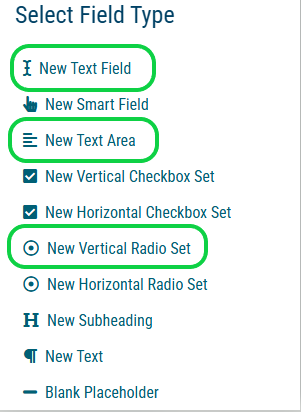
A New Text Field is an option that gives a short amount of space for an answer.
A New Text Area is an option that gives a much larger amount of space for an answer (always select “Rich Text” once you in the selection box).
New Vertical Radio Set will give the option of a yes or no.
For this example, we will choose the New Vertical Radio Set because we want to ask “Is there a course fee?”
+ New Vertical Radio Set
Add Field
In the pop-up window, you would add this information and then click “Save Options”
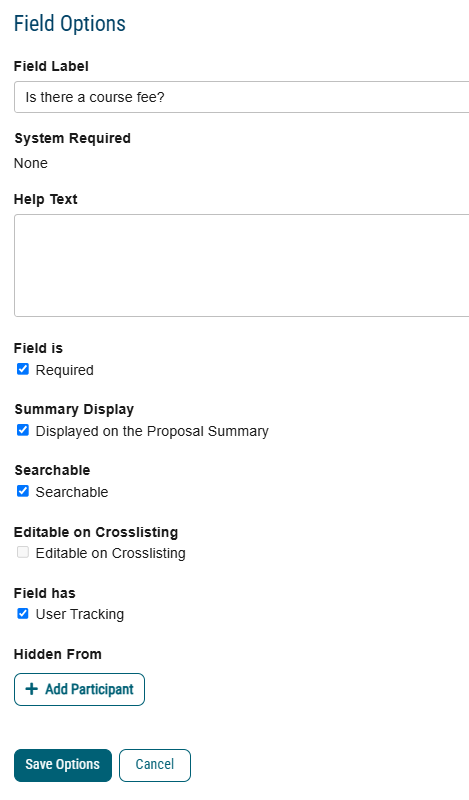
Once you do that, your new field will show up on the proposal form, but it will not have the right options for answers. You will click into the “New Option” and add your answer options.

For this question, we will add, “Yes. A rationale for the course fee is provided below”, and “No”.
Once you do that, you can click on the six light blue dots next to the new field and drag it to where you want in the proposal form.
Since we need to add a rationale section for the course fee, we will go back to the bottom and choose +Add Row to General Catalog Information Section again and Add Field.
Since we want to give them the option of a lot of text, we will select “New Text Area”. In the pop-up window, you will add the information below and choose Save Options. This field should not be required because if they answer “no” to the course fee, then they will not need to provide a rationale. If they answer “yes” to the course fee and they do not provide a rationale, you can send it back to them during the catalog change cycle for them to enter that information.

Complete these steps, using the appropriate new fields, until you have made all of the changes on your master spreadsheet. If you want to see how the form will look once published, you can scroll all the way to the top and select “Preview Form”. This is a good place to see all of the “help” text.

Help Text:

Once all proposal forms have been updated, you will distribute to OAA and the Registrar for them to make edits before you validate and launch the approval process. Validation and launching will be covered in a subsequent procedure.
|




























































